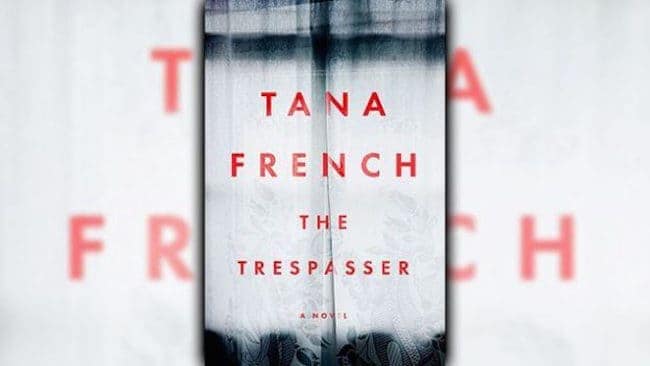As reviewers are writhing all over themselves in praise of Tana French’s latest mystery, The Trespasser, allow me to remove myself from the frothing queue. Still bruised by her last book, I’ve been bruised all over again by this one.
I had devoured French’s In the Woods with an almost unnatural passion. I tore through most of that novel’s 425 pages without breathing, awaiting what had to be a spectacular denouement given the harrowing, granular plot that filled this emotionally charged mystery. So it was with something like a classic case of coitus interruptus that I responded, in the end, to the shocking realization that French was actually going to refuse to tell us what frickin happened back there, in the woods. Not fair!
Nonetheless, I was willing to take another chance when I saw The Trespasser —after all, who in their right mind can resist a murder mystery featuring the foul-mouthed, short-tempered detective Antoinette Conway and her mild-mannered fellow newbie Steve Moran? Welcome to the sixth installment of French’s intimate crime capers embedded deep within the Dublin Murder Squad. Just to get close to the linguistically baroque arsenal of expletives that ripple through the average day on the Dublin streets was worth the price of the book alone.
Skanger; gob; gaff; jacks; kax; kip: tosser: bugger-all.(trans: Filthy foreigner; mouth; home; toilet; more toilet; food; upper-class fop; f-word to everybody). Crunchy crispy urban slang that features myriad alternatives for mysogynist, racist, classist, and mostly scatological proper nouns and active verbs. Bugger-all may be the cleanest of the “bugger” family, and this digression serves simply to clarify that no, The Trespasser is not the sort of book I could recommend to me mum.
Don’t get me wrong. It’s not the excrement, sexual slang, or rampant anatomical argot that I mind. Au contraire. I’m as salty as the next daughter of Ireland. It’s that almost from the start, we can watch the plot being plotted. We can almost see French consulting a playlist. Hmm, have I used Conway’s uncontrollable temper outbursts in the past ten pages? Nope. Grand. I’ll throw in one of her inner asides: “If he looks at me sideways once more I’ll shove his head up his arse.” That kind of thing. Here’s another of the angry detective’s self reflections:
“I can’t wait for them all to bring it on. Danger doesn’t bother me; I’ll eat danger with a spoon. Breslin the puffed-up little tosspot, trying to twist me like a balloon animal, he made me feel like I was in a straitjacket and writhing to punch him.”
We get the picture. Conway is one tough cookie. Problem is, Conway offers these interior musings about what she’ll do to some fool of a detective frequently. Very frequently. Too frequently. It’s a go-to strategy, as if French is insisting to us, the reader, that her female detective is every bit as raw, rough, and capable as the guy detectives. French places too much reliance on the same repeating anger issues. Conway always lets us know just how much she wants to deck someone. Way too much redundant grumbling and groveling and rummaging around the lackluster ecology of the Dublin detective scene. Dashiell Hammett would be appalled.
We know that French can craft sensitively-observed descriptions. Here we meet an early informant:
She opens the door fast and wide awake. She’s short and fit, the kind of fit you get from life, not from the gym—she wears it like it’s owned, not rented. Cropped platinum hair with a long sweep of fringe falling in her face—pale face with clean quic features, smudges of last night’s mascara.
Occasionally French dives deeper and comes up with a reason to keep reading. Conway’s nemesis on the force is Breslin.
Once you realize Breslin is an idiot, you start counting the clichés on their way out of his mouth and noticing that the slick hair is organized over a balding spot, and somewhere in there you realize that he’s actually only around five foot ten and his solve rate is nothing special and you start wondering if he wears a girdle.
Unfortunately Tana French delivers exactly no payoff for all my wading through 500 pages of complaining, nagging, drinking of cold coffee, musings about why she has no friends on the force (she could have asked me), reflections on just how tired she is, hungry she is, sick of the other detectives she is. There is no attempt to give us a character—any character—to hang our allegiance on. Conway is a bitter, complaining stick figure. Her partner Moran is even less fleshed out. All of the heavy lifting in The Trespasser is done by a plot as transparent as Clingwrap. Red herrings abound, especially (SPOILER alert) the gratuitous guest appearance of the long lost dad. An old partner who now works undercover is called in for a house visit that goes exactly nowhere. A maybe boyfriend, another missing father, possibly gang-related clues. Or not. Clues lead down blind alleys. Dialogue goes in circles, with heavy handfuls of expletives thrown in to grease the journey and to assure us that Conway is really getting angry now.
And in the end—holy jacks!—the person who committed the crime is one we suspected in the beginning, and the poor sod they spend their time trying to convict is—as we all knew from the get-go—not guilty of anything except stupidity.
The Trespasser, written by an obviously skilled and renowned author, cries out to be read. And then it cries out to be put down. It’s one giant tease. It leads nowhere either interesting or unexpected, and yet we’ve been asked to follow the author and her slim cast of cardboard characters through a tedious loop of (very quickly) predictable jargon and stake-outs. Where are Dalziel and Pascoe when we need them?


